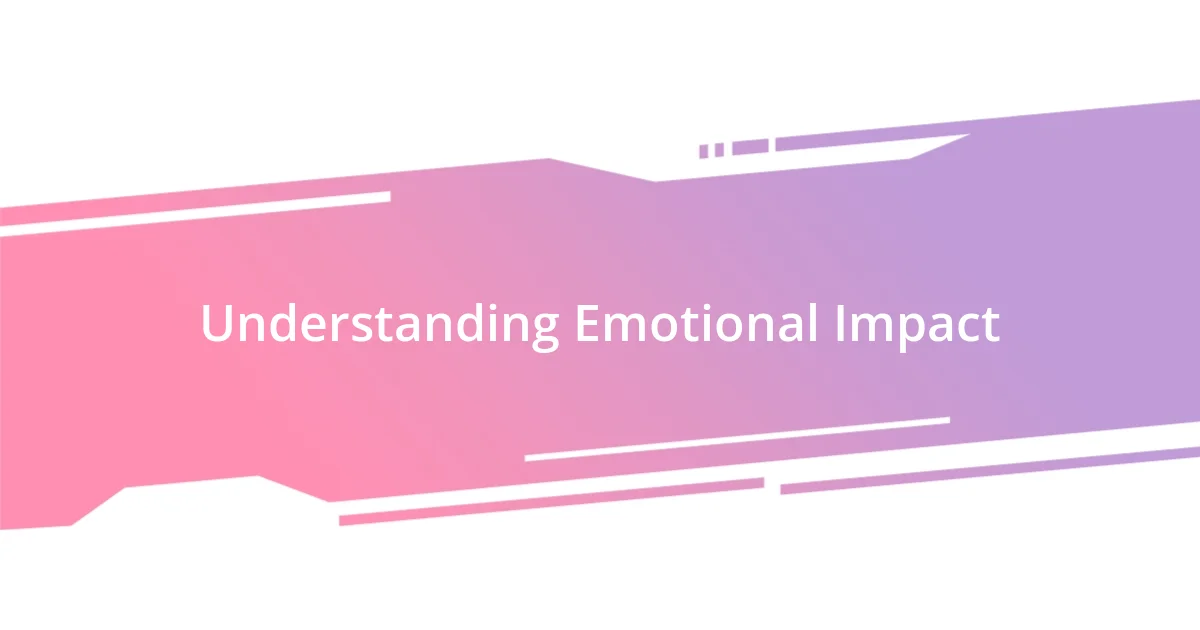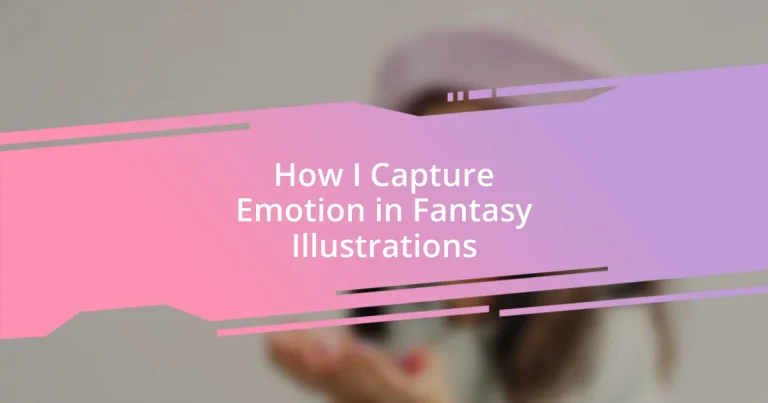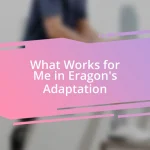Key takeaways:
- Color choice significantly influences emotional impact; warm tones evoke passion while cool tones promote calmness.
- Integrating character expressions, body language, and context enhances viewer connection and emotional depth in illustrations.
- Consistent character development, along with the use of symbols and dynamic composition, enriches storytelling and emotional resonance.

Understanding Emotional Impact
Understanding the emotional impact of any visual art, especially in fantasy illustrations, can be both profound and complex. I’ve often found that the choice of color can evoke specific feelings; for instance, warm tones like reds and oranges can radiate warmth and passion, while cooler shades might foster a sense of calm or isolation. Have you ever noticed how a single hue can change the mood of an entire scene?
When I illustrate, I also think about the characters’ expressions and body language. One time, I created a piece with a hero facing overwhelming odds, his stance a mix of determination and vulnerability. That moment resonated deeply with me, and I wondered—how can I make viewers feel that same tension? It’s this combination of expression and action that can draw people into a visual story, making them feel a part of that emotional journey.
I believe that emotional depth often lies in the subtleties. For example, the smallest details, like a tear glistening or a hand reaching out, can amplify feelings of loss or hope. Each time I work on a piece, I ask myself, “What do I want the viewer to feel?” By honing in on that question, I strive to create illustrations that compel an emotional response, allowing viewers to not just see but feel the narrative unfold before them.

Choosing Appropriate Color Palettes
When selecting color palettes, I often rely on my emotional intuition. Colors can convey a spectrum of feelings; for example, using deep blues and greens can evoke tranquility or mystery, while bursts of vibrant yellow can ignite joy and optimism. Sometimes, as I mix colors, I reflect on personal moments—like the serene feeling of a dawn sky, which inspires me to replicate that harmony in my work.
I remember working on an illustration of a fantastical landscape—lush and enchanting, filled with delicate flowers and ethereal creatures. I chose a palette that blended dreamy pastels with vivid accents to elicit a sense of wonder and enchantment. It’s fascinating how these choices can alter the viewer’s experience; I’ve seen people linger on pieces where the colors resonate with an emotion or memory of their own, making the artwork feel personal.
To clarify how color palettes can shift emotional tone, here’s a comparison table featuring different color combinations and their effects:
| Color Palette | Emotional Impact |
|---|---|
| Warm Tones (Reds, Oranges) | Passion, Energy |
| Cool Tones (Blues, Greens) | Calm, Serenity |
| Pastels | Joy, Tenderness |
| Dark Shades (Blacks, Deep Reds) | Mystery, Intensity |

Incorporating Character Expressions
When it comes to character expressions, I find that the eyes truly are the windows to the soul. A slight squint or a glimmer of light can convey the character’s inner turmoil or joy in unexpected ways. I recall a time I illustrated a villain with a sinister smile paired with narrowed eyes; the expression sent chills down my spine as I worked on it, and I hoped the viewer would feel that unsettling thrill too. It’s intriguing how a well-crafted expression can capture a moment that speaks volumes without uttering a single word.
Here are a few key elements I focus on when incorporating character expressions:
- Facial Details: Subtle changes in eyebrows or mouth shape can significantly alter a character’s emotion.
- Body Language: Posture and gesture often complement the expression to create a fuller emotional picture.
- Interaction with Environment: How a character reacts to their surroundings can amplify their emotional state, such as a character standing tall against a storm or shrinking away from darkness.
- Context and Backstory: Understanding a character’s history helps me depict expressions that resonate with their journey and struggles.
Each of these elements invites viewers to connect on an emotional level, transforming mere illustrations into relatable narratives.

Utilizing Dynamic Composition Techniques
Dynamic composition techniques play a crucial role in creating emotion within my fantasy illustrations. For instance, I often use diagonal lines to guide the viewer’s eye through the artwork, adding a sense of movement and tension. I remember one piece where I positioned a character on a jagged cliff, with sharp lines leading down to a turbulent sea below. This composition not only showcased the character’s bravery but also evoked a feeling of danger and uncertainty, inviting viewers to share in that moment of peril.
Incorporating elements like scale and perspective adds layers to the emotional impact. I once illustrated a scene where a small figure stood before a towering dragon. By emphasizing the size difference, I aimed to evoke feelings of awe and fear. It’s fascinating how these technical decisions can elicit a visceral response from viewers; they might feel the character’s vulnerability as they face such a colossal creature.
I also experiment with framing within my compositions. I often create foreground elements that partially obscure the main subject, drawing viewers into a story or a moment of intrigue. I’ve found that this technique enhances curiosity—will the character overcome the obstacles in the shadows? It’s a subtle invitation for viewers to engage with the artwork, prompting them to delve deeper into the narrative that I’m weaving. What about you? Have you considered how the arrangement of elements in your own artwork can shape an emotional experience?

Creating Atmosphere with Lighting
Lighting is one of the most critical aspects I consider when creating atmosphere in my illustrations. For instance, I once illustrated a cozy cottage at dusk. The warm glow from its windows contrasted against the deep blue of the evening sky, instantly inviting viewers into a feeling of comfort. It’s amazing how different lighting can evoke a plethora of emotions; that scene made viewers wish they could step through the canvas and join the characters inside.
I’ve experimented with harsh, dramatic lighting that casts long shadows, enhancing tension in my artwork. I remember a particularly intense piece featuring a lone warrior facing off against a monstrous creature. By using stark lighting, I highlighted the character’s determination while plunging the monster into shadows, which added an air of menace. How does light transform your perception of danger in an illustration? I find that the right use of lighting can shift a viewer’s entire emotional response in an instant.
Moreover, the choice between warm and cool tones plays a significant role in setting the mood. I once created a fantasy landscape bathed in golden light, symbolizing hope and new beginnings. Conversely, a scene engulfed in blue hues often signifies sadness or mystery, creating an emotional depth that resonates with viewers. I invite you to explore how varying types of light influence your own work. What stories are waiting to be uncovered with the flick of a brushstroke?

Enhancing Storytelling Through Symbols
Symbols are powerful tools in storytelling, allowing me to convey complex emotions and themes in a concise manner. For example, I often incorporate a rising sun to symbolize hope or renewal in a character’s journey. In one illustration, the sun broke through dark clouds behind a protagonist, visually representing their overcoming adversity. This not only gave the artwork a clear focal point but also created an emotional resonance that viewers could instantly connect with.
I also enjoy using color symbolism to enhance the emotions conveyed through my illustrations. In one piece, I portrayed a character surrounded by autumn leaves, their vibrant red and orange hues echoing joy and nostalgia. This element spoke to the fleeting nature of time, prompting viewers to reflect on their own memories of change. How do you use colors and symbols in your work? It’s intriguing to see how every choice can deepen the narrative.
Additionally, I’ve found that certain objects can carry significant weight in a story. A broken sword, for instance, might symbolize lost glory or a character’s past mistakes. I remember illustrating a scene where a hero stood amidst the ruins of a battlefield, clutching the hilt of a shattered blade. The imagery of despair was palpable, inviting viewers to ponder the cost of conflict. What objects in your art have deeper meanings? Engaging with symbols can truly elevate our storytelling and make it resonate on multiple levels.

Practicing Consistent Character Development
Consistent character development is essential for creating relatable figures that resonate emotionally with the audience. In my practice, I focus on tracing a character’s emotional journey through visual cues like facial expressions and body language. I remember devising a character who started as a timid apprentice, only to grow into a fierce warrior. By subtly changing her posture and expressions throughout various illustrations, I conveyed her transformation, which allowed viewers to feel her struggles and triumphs as if they were their own.
I often ask myself how I can make my characters feel real, and I’ve found that layering their backgrounds helps. For one project, I crafted a hero whose scars told stories of battles fought and lost. Each time I illustrated him, I made sure to highlight those scars, reminding both him and the viewer of his past. This consistency in development not only gives depth to the character but also invites the audience to empathize and connect. How do you think your characters’ histories shape their present in your artwork?
Moreover, I pay close attention to how a character’s evolution reflects their emotions in different scenarios. I once illustrated a grand feast, where a character’s smile betrayed underlying sadness. By capturing these discrepancies in emotion, I explored the complexity of human experience, allowing viewers to decode the layers within the character’s mind. It’s fascinating how a single moment can reveal so much; how do your characters communicate their inner lives through your visual narrative? By nurturing this consistency, we not only build relatable characters but also deepen the emotional impact of our illustrations.














